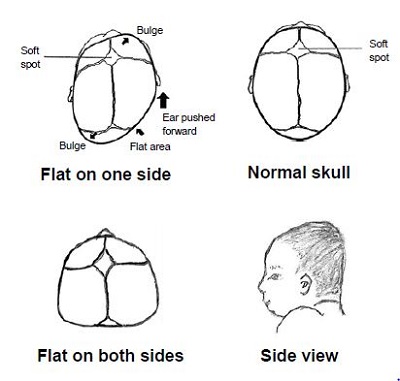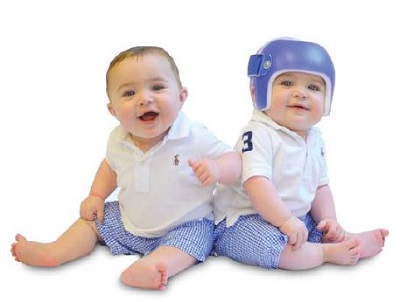Patient EducationJan | 20 | 2020
Plagiocephaly: What You Need to Know
Many parents wonder if their baby’s head is flat or uneven. Learn more about flat head in infants, its causes and prevention, and reshaping tips.
What Is a Flat Head?
A flat head is most commonly caused by a baby’s head being in the same position for too much time. The medical term for flat head is plagiocephaly. Sometimes it is called positional plagiocephaly or occipital plagiocephaly. The skull can take on an abnormal shape on the sides or the back. Positional plagiocephaly is not harmful to your child. It does not affect brain growth or cause brain injury.
What Causes Flat Head?
A baby is born with seven skull bones that grown and join as they get older. During infancy, your baby’s position affects the shape of his head. For example, a baby who spends too much time lying on their back or with their head always turned to one side may get a flat spot on the side or back of their head (see figures).
What Does Positional Plagiocephaly Look Like?

What Can I Do to Prevent Flat Head?
- Avoid keeping your baby’s head in the same position all of the time. Try these tips to help:
- When your baby is awake, give them as much “tummy time” as possible. This decreases pressure on the back of their head. It also helps them gain strength to lift and move their head from side to side.
- Babies should always sleep on their backs to reduce the risk of sudden infant death syndrome (SIDS). When your baby is on their back in the crib, change the direction you place their head. An easy way to remember this is to place their head at the foot of the crib on even-numbered days and at the top (or head) of the crib on odd-numbered days. In addition, turn their head to the right one day and to the left another day.
- If your baby starts having a flat area on their head, try to decrease the time your baby spends with their head on that side. Put exciting things to look at (people, mobiles, mirrors, etc) on the other side so they will look that way instead. You can also change the location of the crib or high chair in the room so they will look away from the flat side.
- Limit the time your baby spends in a car seat, swing or bouncy seat. When the back of their head rests against something, it puts pressure on that area and can lead to flattening. Instead, try holding them in an infant carrier or give him tummy time on a blanket when they are awake.
Does My Baby Need a Helmet?
Sometimes your baby’s plagiocephaly will not improve with these treatments. They may need a molding helmet to help shape the head as it grows.
- If your pediatrician decides your baby could benefit from a helmet, they will refer your baby to a specialist.
- If the specialist agrees a helmet is necessary, they will measure your baby’s head and order a custom made helmet.
- Your child will need to wear this helmet at least 20 hours per day.
- You will visit the specialist often to check on your baby’s progress.
Will My Baby's Head Look Normal?
Medical studies show that positioning or helmets correct the shape of the head about 50 percent of the time. Plagiocephaly is usually not noticeable by school age. The best treatment for flat head is to prevent it by following the recommendations.
Other Concerns
Craniosynostosis
There are some rare but serious causes of a flat head. Craniosynostosis is the name for a skull deformity that occurs if the skull bones fuse too early before the head and brain are finished growing. The changes are usually noticeable at birth. Your pediatrician can determine if this is the case when they examine your child. Your pediatrician may also order some imaging tests to look at the bones of the skull. If your baby has craniosynostosis, they will need to see a neurosurgeon for further advice.
Torticollis
If you feel your baby always prefers to look to one side or has trouble moving their head in one direction, their neck muscles may be tight or weakened. This is called torticollis. Talk with your child’s pediatrician about this. They can recommend exercises to help relax the neck muscles. Your pediatrician may also refer your baby to a physical therapist who will teach you how to relax and strengthen your baby’s neck muscles. Once your baby starts to move their head in both directions, the plagiocephaly will get better. It will also improve once your baby starts to roll over and sit with their head supported. As soon as they can do these things, encourage them as much as possible.
Rev. 10/2012. Mass General for Children and Massachusetts General Hospital do not endorse any of the brands listed on this handout. This handout is intended to provide health information so that you can be better informed. It is not a substitute for medical advice and should not be used to treatment of any medical conditions.
Related Pages
Type
Centers and Departments
Topics
Patient Resources
Patient Resources for Pediatric Neurology
Appointments and Referrals
Request an appointment or second opinion, refer a patient, find a doctor or view test results with MGfC's secure online services.

